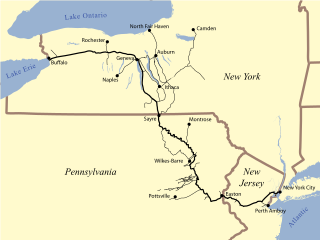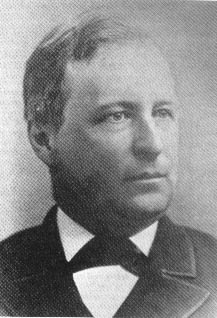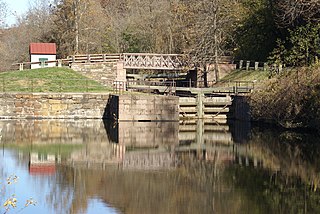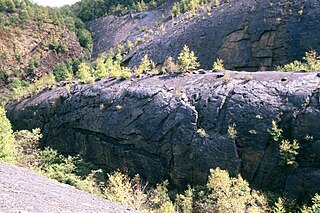
Luzerne County is a county in the U.S. state of Pennsylvania. According to the U.S. Census Bureau, the county has a total area of 906 square miles (2,350 km2), of which 890 square miles (2,300 km2) is land and 16 square miles (41 km2) is water. It is Northeastern Pennsylvania's second-largest county by total area. As of the 2010 census, the population was 320,918, making it the most populous county in the northeastern part of the state. The county seat and largest city is Wilkes-Barre. Other populous communities include Hazleton, Kingston, Nanticoke, and Pittston. Luzerne County is included in the Scranton–Wilkes-Barre–Hazleton Metropolitan Statistical Area, which has a total population of 555,426.

Anthracite, often referred to as hard coal, is a hard, compact variety of coal that has a submetallic luster. It has the highest carbon content, the fewest impurities, and the highest energy density of all types of coal and is the highest ranking of coals.

The Schuylkill River is an important river running northwest to southeast in eastern Pennsylvania, which was improved by navigations into the Schuylkill Canal. Several of its tributaries drain major parts of the center-southern and easternmost Coal Regions in the state.

The Lehigh Valley Railroad was one of a number of railroads built in the northeastern United States primarily to haul anthracite coal. The railroad was authorized on April 21, 1846, for freight and transportation of passengers, goods, wares, merchandise and minerals in the U.S. state of Pennsylvania and the railroad was incorporated/established on September 20, 1847, as the Delaware, Lehigh, Schuylkill and Susquehanna Railroad Company. On January 7, 1853, the railroad's name was changed to Lehigh Valley Railroad. It was sometimes known as the Route of the Black Diamond, named after the anthracite it transported. At the time, anthracite was transported by boat down the Lehigh River; the railroad was meant to be faster transportation. The railroad ended operations in 1976 and merged into Conrail along with several northeastern railroads that same year.

Anthracite iron or Anthracite 'Pig Iron' is the substance created by the smelting together of anthracite coal and iron ore, that is using Anthracite coal instead of charcoal to smelt iron ores — and was an important historic advance in the late-1830s enabling great acceleration the industrial revolution in Europe and North America.

The Coal Region is a historically important coal-mining area in Northeastern Pennsylvania in the central Ridge-and-valley Appalachian Mountains, comprising Lackawanna, Luzerne, Columbia, Carbon, Schuylkill, Northumberland, and the extreme northeast corner of Dauphin counties. Academics have made the distinction North Anthracite Coal Field and South Anthracite Coal Field, the lower region bearing the further classification Anthracite Uplands in physical geology. The Southern Coal Region can be further broken into the Southeastern and Southwestern Coal Regions, with the divide between the Little Schuylkill and easternmost tributary of the Schuylkill River with the additional divide line from the Lehigh watershed extended through Barnesville the determining basins.

The Coal strike of 1902 was a strike by the United Mine Workers of America in the anthracite coalfields of eastern Pennsylvania. Miners struck for higher wages, shorter workdays and the recognition of their union. The strike threatened to shut down the winter fuel supply to major American cities. At that time, residences were typically heated with anthracite or "hard" coal, which produces higher heat value and less smoke than "soft" or bituminous coal.

Franklin Benjamin Gowen served as president of the Philadelphia and Reading Railroad in the 1870s/80s. He is identified with the undercover infiltration and subsequent court prosecutions of Molly Maguires, mine workers, saloonkeepers and low-level local political figures arraigned and tried for multiple acts of violence, including murders and attempted murders of coal mine operators, foremen and workers, and peace officers.

Schuylkill Canal is the common, but technically inaccurate, name for the Schuylkill Navigation, a 19th-century commercial waterway in and along the Schuylkill River in the U.S. state of Pennsylvania. The "canal" was actually a system of interconnected canals and slack-water pools in the river, which is called a navigation. Chartered in 1815, the Schuylkill Navigation opened in 1825 to provide transportation and water power. At the time, the river was the least expensive and most efficient method of transporting bulk cargo, and the eastern seaboard cities of the U.S. were experiencing an energy crisis due to deforestation. It fostered the mining of anthracite coal as the major source of industry between Pottsville and eastern markets. Along the tow-paths, mules pulled barges of coal from Port Carbon through the water gaps to Pottsville; locally to the port and markets of Philadelphia; and some then by ship or through additional New Jersey waterways, to New York City markets.

The Lehigh Crane Iron Company was a major ironmaking firm in the Lehigh Valley from its founding in 1839 until its sale in 1899. It was founded under the patronage of Josiah White and Erskine Hazard, and financed by their Lehigh Coal & Navigation Company, which hoped to promote the then-novel technique of smelting iron ore with anthracite coal. This was an important cost and energy savings technique, since either an expensive charcoaling nor coke producing process and transport costs was totally eliminated so produced a great acceleration in the underpinnings of the American industrial revolution.
The Catasauqua and Fogelsville Railroad was built in the 1850s to transport iron ore from local mines in Lehigh and later Berks County to furnaces along the Lehigh River. Originally owned by two iron companies, the railroad later became part of the Reading system, and parts of it remain in operation today.

The Lehigh Canal or the Lehigh Navigation Canal is a navigable canal, beginning at the mouth of Nesquehoning Creek on the Lehigh River in Eastern Pennsylvania. It was built in two sections over a span of twenty years, beginning in 1818. The lower section spanned the distance between Easton, Pennsylvania and the town of Mauch Chunk, present-day Jim Thorpe, Pennsylvania. In Easton the canal met the Delaware and Morris Canals, with which goods could be brought further up the east coast. At its height, the Lehigh Canal was 72 miles (116 km) long.

The Geology of Pennsylvania consists of six distinct physiographic provinces, three of which are subdivided into different sections. Each province has its own economic advantages and geologic hazards and plays an important role in shaping everyday life in the state. They are: the Atlantic Coastal Plain Province, the Piedmont Province, the New England Province, the Ridge and Valley Province, the Appalachian Plateau Province, and the Central Lowlands Province.

The Llewellyn Formation is a mapped bedrock unit in eastern Pennsylvania. It was previously known as the "coal measures" and the post-Pottsville rocks. The formation is named for the community of Llewellyn in Schuylkill County.

The Lehigh Coal and Navigation Company (LCAN) (1988–2010) was a modern-day anthracite coal mining company headquartered in Pottsville, Schuylkill County, Pennsylvania, U.S. which acquired many of the 'Old Company' (LC&N) properties and re-launched the Lehigh Coal Companies brand in 1988. The LCAN ran strip mining operations in the Panther Creek Valley east of Lansford along U.S. Route 209; with vast properties dominating the coal areas of Tamaqua, Coaldale, and Lansford. These properties are largely the same real estate assets as were acquired in the Panther Creek Valley by the predecessors: the haphazard Lehigh Coal Mine Company (1792-1822) and the builders of the Lehigh Canal and first American blast furnaces, the Lehigh Coal & Navigation Company, which spearheaded the U.S. Industrial revolution. The new company was incorporated in 1988 acquiring LC&N assets after bankruptcy proceedings, taking the name of the original.

The history of coal mining in the United States goes back to the 1300s, when the Hopi Indians used coal. The first use by European people in the United States was in the 1740s, in Virginia. Coal was the dominant power source in the United States in the late 1800s and early 1900s, and remains a significant source of energy.
The Grubb Family Iron Dynasty was a succession of iron manufacturing enterprises owned and operated by Grubb family members for more than 165 years. Collectively, they were Pennsylvania's leading iron manufacturer between 1840 and 1870.

There are two types of coal found in Pennsylvania: anthracite and bituminous. Anthracite coal is a natural mineral with a high carbon and energy content that gives off light and heat when burned, making it useful as a fuel. It was possibly first used in Pennsylvania as a fuel in 1769, but its real history begins with a documented discovery near Summit Hill and the founding of the Lehigh Coal Mine Company in 1792 to sporadically send expeditions to the wilderness atop Pisgah Ridge to mine the deposits, mostly with notable lack of great success, over the next 22 years. The owners of this company were absentee management—reliant on teams of workers sent under a foreman to fell timber to build so called 'Arks', then mine coal around nine miles from the right bank Lehigh, then trek with mule loads to fill the boats for the trip down the rapid strewn Lehigh River,(Brenckman, p. 595-597) and then more than 60 miles (97 km) to Philadelphia docks on the unimproved often log choked Delaware River.(Bartholomew, p. 4)






















